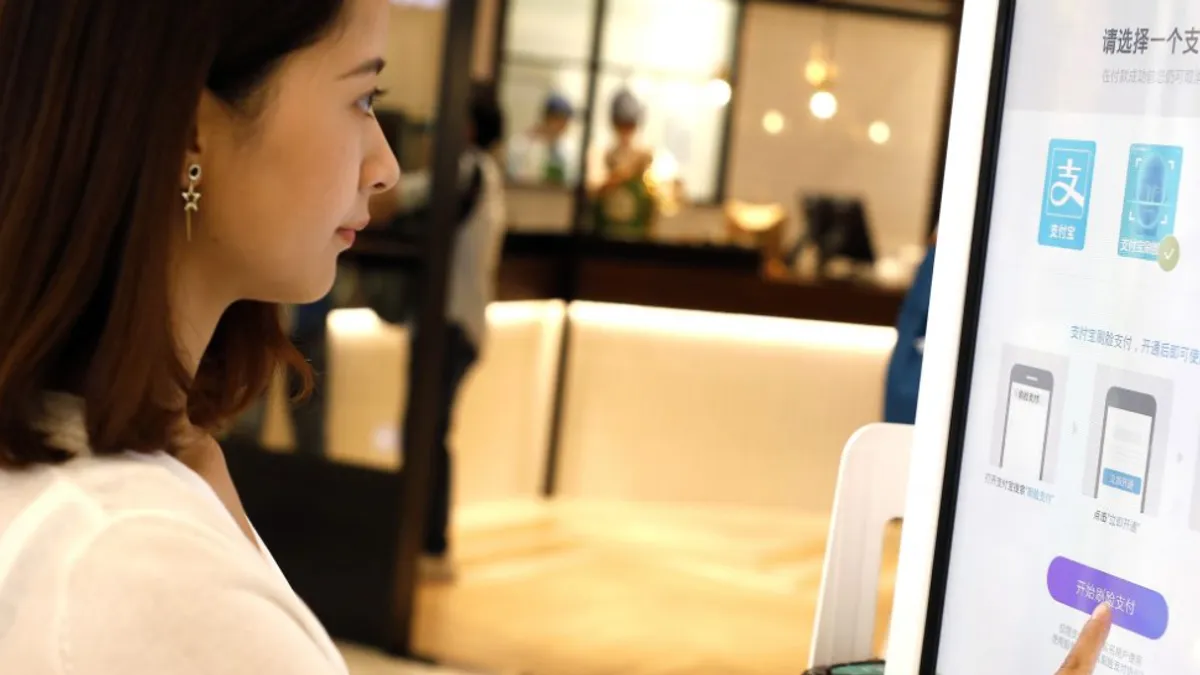In grocery stores around the world, retailers are making big changes to deliver online and offline experiences that will win shoppers over. Mexico’s Soriana grocery chain offers free Wi-Fi in 824 stores for millions of customers. Lidl in Ireland sells musical instruments at its stores during the holidays. On U.S. soil, retailers are investing more in their e-commerce offerings while also raising the bar on their in-store experiences.
China may be showcasing some of the most innovative models of all. The country's retail sector is booming, with big names such as Alibaba and JD.com leading the charge, while an embrace of digital innovation and e-commerce has created a grocery scene blending online and offline capabilities that has quickly become the envy of many U.S. grocers.
American retailers can certainly learn a few lessons from China’s progress in retail, industry experts say. But the differences between the two countries, they note, highlight the limits U.S. operators face in bringing cutting-edge technology to an industry that has long resisted it.
China's middle class boom
China’s grocery industry is shaped heavily by its geography, culture and an infrastructure that is vastly different from the U.S. One of the major catalysts for retail growth in China is its flourishing middle class. According to research from the Brookings Institute, 88% of the next billion people to enter the global middle class will be from Asia, with China specifically adding an estimated 350 million people to the middle class between 2015 and 2022.
“It’s a lot easier for these e-commerce players to come in and first try new formats and then scale them very quickly, because the competition isn’t as robust. There aren’t as many well-sourced, well-funded large retailers."

Michelle Grant
Head of Retailing, Euromonitor International
Along with a rise to the middle class comes more disposable income and an expectation for better food quality, according to Paco Underhill, founder and CEO of Envirosell and author of the book Why We Buy: The Science of Shopping.
“China is moving into the middle class so quickly,” Underhill told Retail Dive's sister publication Grocery Dive. “There is the perception that if I am accessing food products through a modern distribution system, that is one way of insuring myself against food safety issues.”
Underhill also said part of what makes China’s grocery industry unique is the sheer size of its population. While the U.S. has just nine cities with populations exceeding 1 million, China has 125 cities with more than 1 million residents, and e-commerce is exploding in these areas.
Michelle Grant, head of retailing for Euromonitor International, notes that China’s urbanization is relatively new. Up until this point, its retail infrastructure was very fragmented, especially in grocery. “They don’t have behemoths like Walmart spread throughout the entire country,” Grant told Grocery Dive.
Because the country is so large, and due to the highly regional nature of retailers in China, Grant said the landscape is friendly for e-commerce rivals such as JD.com and Alibaba to come in and dominate the retail industry.
“It’s a lot easier for [China's] e-commerce players to come in and first try new formats and then scale them very quickly, because the competition isn’t as robust," she said. "There aren’t as many well-sourced, well-funded large retailers."
Innovations in grocery
Alibaba and JD.com have made major waves in the Chinese grocery market online, and are now combining that channel dominance with innovative brick-and-mortar stores that combine sensory experience with bleeding-edge digital features. Alibaba operates a grocery banner called Hema, which currently has more than 60 locations and plans to reach 100 early this year. In response, JD.com launched its own grocery store called 7Fresh, with four locations so far — and plans for many more
Both stores require customers to download their mobile apps and register for an account to shop there. Once that is done, the seamless experience begins. 7Fresh's first store, located in Beijing, is about 40,000 square feet and boasts a large fresh food and produce selection, as well as international specialties like Spanish Iberico ham, French pastries and seafood from Japan. Shoppers scan barcodes to learn more about items' nutritional value and place of origin on overhead screens, where they'll also see additional product recommendations.
At Hema, shoppers can peruse international foods and wine, as well as an on-site restaurant they can check into through the store app. Mobile checkout runs through Alipay, Alibaba's online payment platform, and Hema uses customer data to ensure that each store stocks the right amount of fresh food, milk, eggs and produce without running out or having a surplus that will go to waste. Shoppers can peruse products in brick-and-mortar locations and, just like 7Fresh's store, choose to take products with them when they leave or have them delivered to their homes.
Grant said that Hema is testing out different technologies at each store because Alibaba is still trying to identify the perfect omnichannel experience. Some stores may have customers pay by QR code, while others will use facial recognition. Endless aisle technology is also being applied in some stores, which allows shoppers to explore products beyond what they see in front of them using mobile phones and in-store digital screens.
One of the most notable offerings from Chinese retailers is the promise of same-day delivery. Both 7Fresh and Hema offer delivery in 30 minutes for customers who live within a three-kilometer radius of a store — something that would be difficult to accomplish in the U.S., which is far less densely populated and has higher labor costs, Grant said.
Large U.S. retailers seem to have confidence in their Chinese counterparts. Amazon’s purchase of Whole Foods in 2017 was likely inspired by Alibaba, which has investments in a variety of brick-and-mortar companies, including a home furnishing chain and an electronics retailer, according to Grant. Walmart bought a stake in JD.com two years ago, and recently expanded the partnership into groceries earlier this year. Walmart maintains physical stores in China and uses JD.com as its online platform for shoppers in the country.
U.S. retailers make their move
When it comes to buying groceries online, Americans have not been all that enthusiastic so far, with a Gallup poll finding that 84% of U.S. grocery shoppers never buy groceries online. China, on the other hand, is home to more than 700 million internet users and accounted for 40% of global retail e-commerce last year. The country’s mobile payment market was more than 10 times the size of the U.S. market.
But food retailers in the U.S. are gaining ground. Growth in online grocery sales are far outpacing growth in grocery sales overall in the U.S. A recent study from Internet Retailer reported that online grocery sales should reach $59.5 billion in 2023, more than double the $23.9 billion they accounted for in 2018. As U.S. retailers make progress in e-commerce and integrate technology into brick-and-mortar stores, experts believe customer adoption will speed up.
Grant said innovation coming from retailers such as Amazon will help drive the spread of e-commerce. Traditional U.S. grocers, however, face the challenge of integrating new features into existing infrastructures. The traditional retail model is one of the biggest challenges facing U.S. retailers when it comes to e-commerce adoption, according to Neil Stern, senior partner at consulting firm McMillanDoolittle.
Stern told Grocery Dive that the Western retail model is built on legacy systems. China, on the other hand, does not have a long history of malls, supermarkets and big box stores. With no ingrained technology systems and retail model to defend, the country is witnessing creation of a “new retail” space, where new formats and business models are simultaneously emerging and adapting to changes with the online shopping environment. Many U.S. grocery companies, Stern noted, have to invest heavily to remodel their stores and update their legacy systems.
The traditional retail model is one of the biggest challenges facing U.S. retailers when it comes to e-commerce adoption.

Neil Stern
Senior Partner, McMillanDoolittle.
Despite their legacy infrastructures, several traditional U.S. grocers are innovating at a rapid pace, bringing technology in to elevate brick-and-mortar as well as drive e-commerce. Kroger has made a number of efforts on the digital front, most recently partnering with Microsoft to equip stores with cloud-based digital shelves that provide pricing, product information, coupons and, at two test locations, a "guided shopping" feature that lights up each product on a shopper's list.
Walmart, meanwhile, has invested more than $11.7 billion in technology to expand online grocery and delivery capabilities, bring robots into stores to help clean and fulfill grocery orders, and test driverless grocery delivery. Walmart-owned Sam’s Club is piloting a scan-and-go model in Dallas that offers a cashier-less experience and may soon include smart shopping lists and electronic shelf labels.
Giant Heirloom Market, a specialty store that opens this week in Philadelphia, mimics Hema's connected-store model by offering iPad stations where customers can order any products they can't find on shelves for next day delivery through Peapod, the e-grocer that's also owned by parent company Ahold Delhaize.
The rise of mobile shopping and the connected store
Another significant driver of e-commerce adoption in China is the role of mobile payments, which have grown at a breakneck pace. About 55% of Internet users in China have made a mobile payment, versus just 19% of Internet users in the U.S., Stern said.
Grant with Euromonitor said that the Chinese leap-frogged to mobile because most consumers access the internet through their smartphones, while the U.S. has more gradually adopted e-commerce across devices. China’s rapid adoption of mobile payments also occurred because the Chinese have never utilized debit or credit cards.
“It was a cash-based society up until about 2014,” Grant said. “Then Alibaba introduced AliPay to bring down the friction in online shopping, because no one had cards.” She said the Chinese quickly adopted mobile wallets, which is a behavior that Americans have not caught onto, despite pay products such as Walmart Pay being available.
As more shoppers become comfortable with the technology and retailers make it a more seamless process, mobile pay will likely become more common in the U.S.
“Having that mobile mindset of how people might be using their phones and experimenting with that is probably the best thing to learn from the Chinese retailers,” Grant said.
Stern agrees that mobile payments will gain traction in the U.S. and become present in both check-out and cashier-less environments, such as Amazon Go and Sam’s Club Now. He’s also optimistic that more U.S. retailers will adopt some of the best features of retail and e-commerce in China. Walgreens, for example, is piloting Cooler Screens that offer smart displays in cooler doors in-store.
Efficient home delivery, according to Stern, will likely become more popular as grocers better utilize their stores and warehouses to provide faster delivery — though this is complicated by the high labor costs in the U.S.
Grant agrees that matching China’s speedy grocery delivery model could be complex. She said 30-minute delivery for customers within a few miles is not likely possible in much of the U.S.
“Kroger is certainly trying – they have their Ocado partnership to aid in delivery. That could bring down costs and help bring it more quickly to consumers,” Grant said. She also notes that new micro-fulfillment centers like those being piloted by Albertsons will bring warehouses closer to people and, hopefully, bring down home delivery costs.
Digital adoption could come at a price, according to Underhill, as grocers put more resources into digital pickup. “The store is becoming more and more like a warehouse. The pleasure factor of walking in, and exploring, and learning — if that starts to deteriorate, what does that mean for the industry?”
From the looks of Hema and 7Fresh, there is no lack of in-store experience. Rather, China’s new retail model has made it possible to deliver a valuable in-store experience that is fully aligned with e-commerce shopping — and that is something American shoppers will increasingly see as local stores find new ways to connect online shopping with the tried-and-true in-store experience.
























